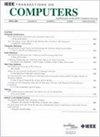Fast Garbage Collection in Erasure-Coded Storage Clusters
IF 3.8
2区 计算机科学
Q2 COMPUTER SCIENCE, HARDWARE & ARCHITECTURE
引用次数: 0
Abstract
擦除编码存储集群中的快速垃圾回收
Erasure code (EC)在集群中被广泛采用,以提供高的数据可靠性和低的存储成本。由于删除和错位更新操作,一些数据块是无效的,这不幸引起了繁琐的垃圾收集(GC)问题。一些限制仍然困扰着现有的设计:大量的网络流量、不平衡的流量负载和GC后较低的读写性能。FastGC是一种快速的垃圾回收方法,它将旧的条带合并成一个新的条带,并回收无效的块。FastGC通过分条分组和位序列操作快速生成高效的合并方案,最大限度地减少网络流量,同时保持相同分条的数据块分布,保证读性能。它在合并过程中仔细地为新条带分配存储空间,以消除影响写性能的不连续空闲空间。为了加快合并后校验更新的速度,FastGC贪婪地调度传输链路进行多分条更新,以平衡节点间的流量负载,并采用最大流量算法使带宽利用率达到饱和。通过仿真和阿里巴巴ECS实验综合评价结果表明,FastGC在保持GC后读写性能的同时,可以显著减少10.36% ~ 81.22%的网络流量和34.25% ~ 72.36%的GC时间。
本文章由计算机程序翻译,如有差异,请以英文原文为准。
求助全文
约1分钟内获得全文
求助全文
来源期刊

IEEE Transactions on Computers
工程技术-工程:电子与电气
CiteScore
6.60
自引率
5.40%
发文量
199
审稿时长
6.0 months
期刊介绍:
The IEEE Transactions on Computers is a monthly publication with a wide distribution to researchers, developers, technical managers, and educators in the computer field. It publishes papers on research in areas of current interest to the readers. These areas include, but are not limited to, the following: a) computer organizations and architectures; b) operating systems, software systems, and communication protocols; c) real-time systems and embedded systems; d) digital devices, computer components, and interconnection networks; e) specification, design, prototyping, and testing methods and tools; f) performance, fault tolerance, reliability, security, and testability; g) case studies and experimental and theoretical evaluations; and h) new and important applications and trends.
 求助内容:
求助内容: 应助结果提醒方式:
应助结果提醒方式:


